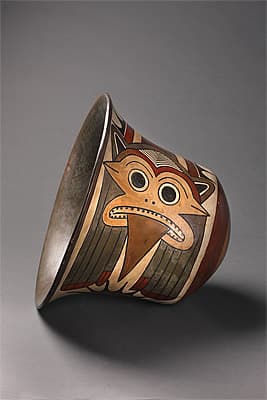
NAZCA culture South coast 100 – 700 AD
Bowl 100-700 AD ceramic28.7 (h) cm 38.2 cm (diameter) Ministerio de Cultura del Perú: Museo Nacional de Arqueología, Antropología e Historia del Perú, Photograph: Daniel Giannoni
The bowl was formed with a rounded base and gently flaring sides, and is painted in polychrome slips. Both shape and imagery are unusual, but the sideways orientation perfectly follows the circular form of the vessel. The side illustrated depicts a supernatural feline known as the ‘cat demon’: it has a protruding tongue, eyes shaped like two birds in silhouette, and its head is attached to the spiked body of a snake or insect. Two red-tipped, grey-striped bands may signify a feather headdress or hair.
The figure resembles a composite deity, as the creatures represent the three levels of the universe: the heavens, the earth and the underworld. Its ferocious expression, split mouth and pointed tongue do not seem to evoke anything but fear or even death. A skilled artist has executed the image with great conviction, using red, yellow, brown and grey on a white ground, with narrow black outlines and a black interior.1
Christine Dixon
1. The bowl has been dated to 1–200 AD, or Early Nazca in Paracas: trésors inédits du Pérou ancien, Paris: Musée du quai Branly and Flammarion 2008, p. 163.
The bowl was formed with a rounded base and gently flaring sides, and is painted in polychrome slips. Both shape and imagery are unusual, but the sideways orientation perfectly follows the circular form of the vessel. The side illustrated depicts a supernatural feline known as the ‘cat demon’: it has a protruding tongue, eyes shaped like two birds in silhouette, and its head is attached to the spiked body of a snake or insect. Two red-tipped, grey-striped bands may signify a feather headdress or hair.
The figure resembles a composite deity, as the creatures represent the three levels of the universe: the heavens, the earth and the underworld. Its ferocious expression, split mouth and pointed tongue do not seem to evoke anything but fear or even death. A skilled artist has executed the image with great conviction, using red, yellow, brown and grey on a white ground, with narrow black outlines and a black interior.1
Christine Dixon
1. The bowl has been dated to 1–200 AD, or Early Nazca in Paracas: trésors inédits du Pérou ancien, Paris: Musée du quai Branly and Flammarion 2008, p. 163.
The bowl was formed with a rounded base and gently flaring sides, and is painted in polychrome slips. Both shape and imagery are unusual, but the sideways orientation perfectly follows the circular form of the vessel. The side illustrated depicts a supernatural feline known as the ‘cat demon’: it has a protruding tongue, eyes shaped like two birds in silhouette, and its head is attached to the spiked body of a snake or insect. Two red-tipped, grey-striped bands may signify a feather headdress or hair.
The figure resembles a composite deity, as the creatures represent the three levels of the universe: the heavens, the earth and the underworld. Its ferocious expression, split mouth and pointed tongue do not seem to evoke anything but fear or even death. A skilled artist has executed the image with great conviction, using red, yellow, brown and grey on a white ground, with narrow black outlines and a black interior.1
Christine Dixon
1. The bowl has been dated to 1–200 AD, or Early Nazca in Paracas: trésors inédits du Pérou ancien, Paris: Musée du quai Branly and Flammarion 2008, p. 163.

